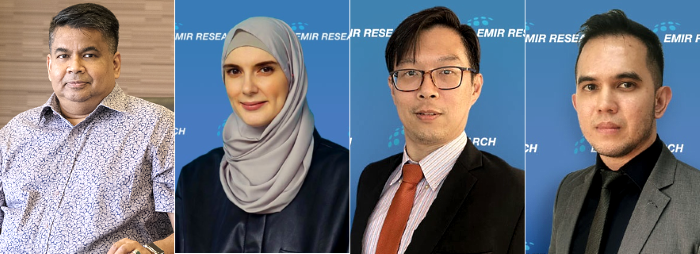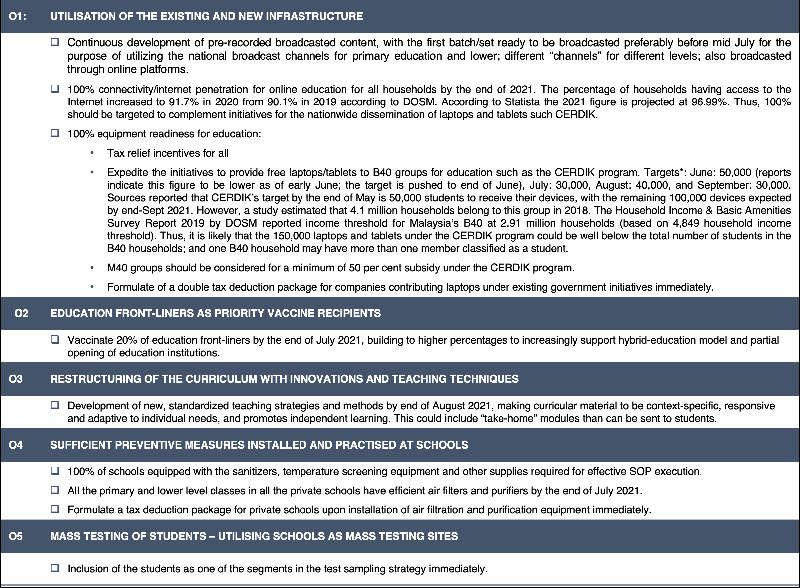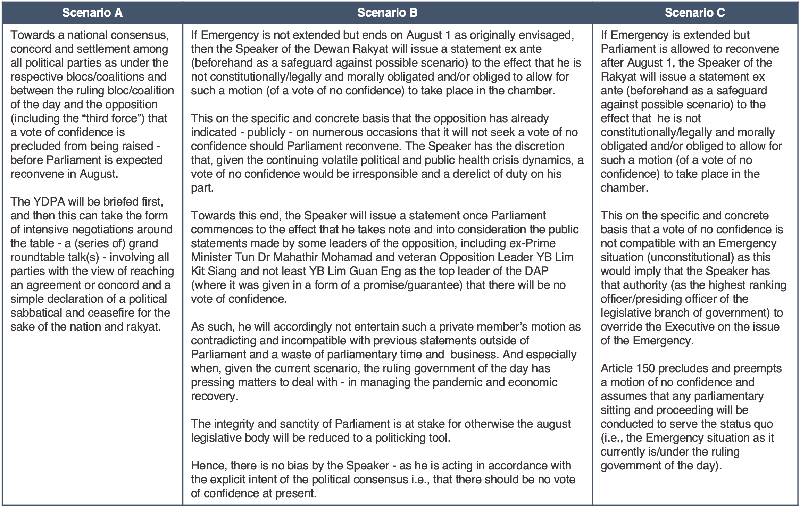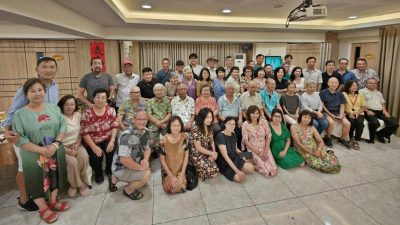By Dr Rais Hussin / Dr Margarita Peredaryenko / Jason Loh / Ameen Kamal

Following Part 1 of the exit strategy building block released on 18 June, 2021 – which elaborated on three main objectives surrounding the immediate measures to protect lives and livelihoods alongside potential targets and success criteria – this Part 2 delves into the subsequent strategic thrusts.
Specifically, this Part 2 concerns the emergency education responses, and national reconciliation. These were developed with a key focus on Malaysia’s circumstances and unique context that requires inclusivity and a whole-of-government approach.
In Part 1, we reiterated, using fundamental principles of economic theory, that the current pandemic-induced crisis is fundamentally different than past crises, which requires a comprehensive strategic approach towards a gradual reopening of the economy.
Positioning its strategy in the uniqueness of the current pandemic-induced crisis, EMIR Research has suggested the following strategy based on 3+1 main strategic thrusts:
1. Protecting lives and livelihoods
2. Education emergency response
3. National reconciliation
4. National economic recovery plan
Overall, it suggests strategies and tactics to complement recently announced steps by the government towards national recovery, whereby it aims to "exit" the COVID-19 pandemic in four phases.
This article covers the second and third strategic thrusts, while the following and last release shall delve into the last strategic thrust—national economic recovery.
Second Strategic Thrust – Education Emergency response
Subsequent to the protection of lives and livelihoods, transitioning into the following phases must not leave out a crucial part of the society that has been severely disrupted – education. Thus, the second strategic thrust concerns the continuation of education despite difficulties for education institutions to physically host students, presenting new challenges to effective education delivery.
Education is the "building block" of the nation and is closely linked with the current and future economy of the country, impacting personal development and social skills, mental and emotional health of household members.
An OECD report estimated that learning loss equivalent to a third of school-year could mean an average of 1.5 per cent lower GDP. The OECD also reported an estimate of future individual income reduction due to education loss. For example, a 50 per cent school-year equivalent loss can reduce a student's future income by 4 per cent (pooled figure).
In addition, it's been reported that Malaysia's school closure duration may have surpassed 50 per cent of the annual school days as of the first quarter this year. Thus, education is a crucial and inseparable part of the "livelihoods" equation.
The five key objectives of this thrust are outlined below:
Goal 1: Provide education continuity for the education workforce and students.
Objective 1: Utilization of the existing and new infrastructure.
In ensuring that there is little to no disruption in education for all levels, education should be disseminated using existing broadcast capabilities for primary and lower levels of education.
Given that households may have limited television capacity to put on different channels for different levels, it is necessary to ensure these concurrent streams be made accessible via other platforms such as mobile devices and laptops.
The prerequisite for any other internet-based alternatives is high-speed internet connectivity and electronic human interface devices (laptops, tablets, smartphones etc.).
Objective 2: Education frontliners as priority vaccine recipients.
To prepare teachers and school administration/staff for the reopening of education institutions, there must be support for policies such as hybrid education and partial opening of education institutions. Subject to outcomes of clinical trials for vaccination on toddlers and children, these groups may have to be considered for vaccination as well.
Objective 3: Restructuring of the curriculum with innovations and teaching techniques.
It is well known that online teachings have drawbacks such as focus retention for self-learning and effective delivery of online instructions – all of which require new teaching strategies. As researchers have reported, this includes making curricular materials context-specific, responsive, and adaptive to individual needs and promoting independent learning. In support of hybrid-learning systems, this may include "take-home" modules that can be sent to students.
Objective 4: Sufficient preventive measures installed and practiced at schools.
Relevant authorities must ensure the sufficiency of sanitizers, temperature screening equipment and even air-purifiers and filters in all educational institutions before they reopen.
Private schools should be immediately incentivized to install the latest air filtration and purification equipment with the optimal settings according to the recent standards derived in consultation with the epidemiologists and experts in all of the classes designated for primary level students and below.
The same measure might be considered for the public schools; however, obviously, public schools will require heavier subsidies from the Government.
This strategic move, in combination with the above Objective 2, may allow a large number of students of primary level and below safely return to face-to-face classes as soon as possible, while secondary and tertiary students may continue online education longer.
Tracking the installation of air-filtration systems and purifiers in the schools also has easier-established targets, unlike, for example, delivery of laptops or mobile devices to those in need, which can be very difficult to estimate precisely.
From the long-term perspective, the Government should target upgrading and installing top-notch air filtration and purification systems at the premises of all the public education institutions. The presence of such equipment must be made according to education industry standard and requirement. The current pandemic underscored the importance of this overlooked area.
Objective 5: Mass testing of students – utilizing schools as mass testing sites.
Students from the younger age group could have been part of an under-tested segment of society under-looked in pandemic management all this while.
Schools are strategically located in localities and are ubiquitous in the community. These could be underutilized facilities for mass testing. A list of students from a particular can be called up in stages at schools to be tested.
This allows increased detection and isolation of cases that would add to the testing database for better test–positive representation. Positive tested students will be linked back with members of his or her households to be quarantined and tested.
The overall impact is higher testing, detection, isolation, and treatment of cases.
Upon reopening of schools, tests at schools should be done at random to continue with increasing intensity.
The following figure summarizes the proposed targets for each of the above objectives to track the progress.

Third Strategic Thrust – National Reconciliation
The current state of politics in Malaysia in itself presents significant risks to the well-being of the rakyat in the face of all the pandemic- and economic-related challenges. Therefore, managing the political climate is another essential strategic thrust to facilitate pandemic management and future economic recovery.
This strategic thrust requires the combination of the following short-, medium- and long-term goals.
Goal 1: Political sabbatical (under the Emergency – including if extended beyond August 1) – To ensure that politicking is reduced or minimized, or effectively managed.
Objective 1: Provide for a guided transition towards the ending of the Emergency and reconvening of Parliament.


Goal 2: Political stability (post-Emergency: short- to medium-term) – To ensure that post-Emergency, parliamentary democracy that has been restored will function effectively in focusing on national recovery efforts.
Objective 1: Providing for a functioning Parliament – either in full capacity or hybrid (i.e., part-physical, part-virtual) under conditions agreed upon by all parties, i.e., the ruling government of the day and the opposition.

Goal 3: Political normalization (post-Emergency: long-term) – Ensure that the general election can be held once herd immunity is achieved or (hopefully) by 2023.
Objective 1: Providing for a general election under a safe and secure environment/conditions.

The third and the last part will be discussing the strategic thrust related to national economic recovery.
(Dr Rais Hussin, Dr Margarita Peredaryenko, Jason Loh and Ameen Kamal are part of the research team of EMIR Research, an independent think tank focused on strategic policy recommendations based on rigorous research.)
ADVERTISEMENT
ADVERTISEMENT


































